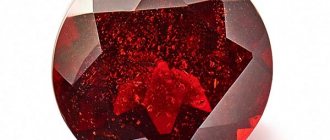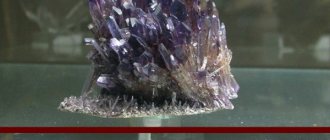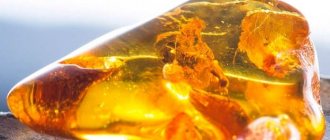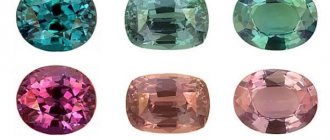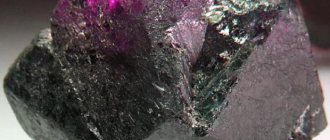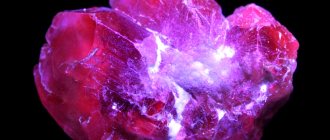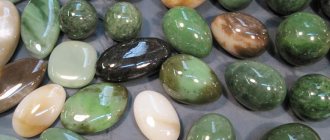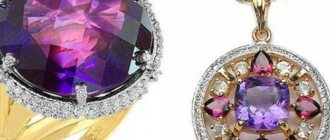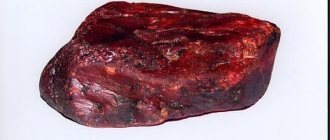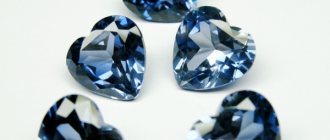Artificial alexandrite is increasingly replacing natural alexandrite. But even a laboratory-grown crystal is a coveted gem in many people’s collections. This stone has the property of changing color under different lighting conditions. Alexandrite stone is almost never found in nature, which explains its high cost. But modern industry has learned to produce synthetic alexandrites, which are inferior to their natural counterparts only in the range of shades. Let's find out how to distinguish natural alexandrite from artificial one, and what are the properties of this jewelry.
History of the gem
The alexandrite stone has a rich history; mentions of it are found in ancient Indian treatises. According to the official version of many researchers, the gem received its name in 1834. The Swedish scientist Nordenskiöld searched for precious stones in the area of emerald mines in the Urals. In the mica dumps, the seeker found a beautiful stone of an unusual color. Its color shimmered under the rays of the sun from yellow to green. Initially, the scientist suggested that it was an emerald. However, the mineral found was superior to emerald in hardness. In the evening, in the light of a candle flame, the gem sparkled with purple-red hues.
Count Perovsky, while in St. Petersburg, carefully studied the mineral and classified it as a separate group of gems. The first attempts to name the find “diaphanite” (translated from Greek as “double shine”) were unsuccessful.
The stone of a beautiful shade was presented to the general public on the day of the coming of age of the future Emperor Alexander II.
Taking into account the fact that this mineral is a leader in counterfeiting and counterfeiting, the question of how to distinguish natural alexandrite from synthetic one is very relevant.
Properties
In Russia, the imperial stone, due to a combination of circumstances - the death of Emperor Alexander II and the consequences of the First World War, acquired a bad reputation, meaning grief, loss of a loved one and loneliness.
Alexander II was very fond of the gem given to him and wore a ring with this stone, never parting with it. However, on March 1, 1881, the tsar, for some unknown reason, did not put on the ring with alexandrite and was killed on that day. This confluence of events looks somewhat strange if you also know the fact that March 1 in magic circles is considered one of the most difficult and unlucky days of the year - according to legend, on this day Judas hanged himself.
However, in other parts of the world, chrysotile beryl is treated more loyally and sees only good things in it. Due to its unique ability to change color, alexandrite is credited with various magical properties - this is understandable, because ordinary people are accustomed to classifying everything that cannot be explained as a miracle.
In Russia, it is believed that alexandrite is capable of enhancing the gift of intuition and prophecy, so mediums use the stone to make various talismans and amulets that help not only predict future events, but also protect their owner from the evil eye and damage. In addition, it was believed that the chameleon stone could cure alcohol addiction. To do this, alexandrite had to be left in a container with water all night, and upon waking up in the morning, before breakfast, drink this water.
In India, the miracle stone is considered a symbol of health, longevity and financial prosperity. The first mention of it is contained in an ancient treatise called “Mahabharata”, where alexandrite is compared to a peacock feather and called “peacock’s eye”. Not every person can afford an amulet with such a rare stone, but the owner of such an amazing treasure was considered lucky in all endeavors and vital matters.
In European countries, alexandrite is considered a stone that attracts good luck and helps to establish new relationships, not only of a romantic, but also of a business nature.
Description of the mineral
Before you learn how to distinguish alexandrite from other stones, you need to get acquainted with the description of the mineral.
Alexandrite is a chrysoberyl. It has extreme hardness. When exposed to artificial natural light, it can change its color. Jewelers call this property reverse.
Rays of light, refracted through the crystal lattice of a mineral, give a different spectrum. As a result, we see different shades.
The reverse is also explained by the special chemical composition of the gem. Alexandrite contains trivalent chromium and absolutely no silicon.
Properties of the mineral:
- Color – yellow, green, blue, purple, red. The gem can change its color in infrared and fluorescent lighting.
- Hardness on the Mohs scale is 8-8.5 units. Alexandrite is slightly inferior to diamond (10 units) and sapphires (9.5 units).
- Density – 3.6-3.8 g/cm³.
- Resistant to acids (with the exception of hydrofluoric acid and boric acid).
- Alkalis have an adverse effect on the mineral.
- Melting point – 1800°C.
- Refractive index – 1.74-1.75.
- Optimal birefringence indices are 0.008-0.01.
- Does not respond to magnets. In some cases, a slight attraction is possible.
Synthetic and natural analogues
To distinguish alexandrite from a fake, you need to know what stones are similar to it. There are synthetic gems, grown in laboratories and industrial conditions, and natural ones, but belonging to other groups of minerals. The color of the stones may be very similar to their natural counterpart, but they will differ in hardness and reverse.
The jewelry industry does not stand still, and very plausible imitators of alexandrite have appeared.
Similar to alexandrite:
- Synthetic corundum, that is, artificial stone. It perfectly conveys the color of alexandrite, has increased hardness and even shimmers in all shades of the spectrum. However, if a corundum gem is held up to light, the mineral will turn yellow. The original stone will shimmer in many shades, including yellow. But this color will not become dominant in the overall color scheme. Even 30-50 years ago, corundum was widely used to imitate alexandrite in many jewelry. Nowadays this is rare.
- Synthetic spinel. Widely used in the manufacture of jewelry with imitation alexandrite. It reproduces the color shades of the original well, but the spinel completely lacks the yellow color. This stone comes in many shades, changing color from pink to blue. In daylight, spinel has a violet-blue hue, while alexandrite shimmers from green to red.
- Glass. By adding special chemical elements (chrome, nickel) to a regular glass alloy, jewelers can get stones very similar to alexandrite. However, they will be almost half as hard as the original. Such a fake will be inexpensive, but it’s not worth talking about good quality.
Alexandrite can also be replaced by natural precious stones, which will resemble the original in shade. This phenomenon is called pleochroism.
A successful analogue would be:
- Ruby. You won't be able to spot a fake on your own. The minerals have a very similar color scheme, and ruby also has an orange color in the palette. In terms of cost, the products will be in the same price category, both with ruby and with alexandrite.
- Tourmaline. The watermelon variety of the gem is often passed off as the original. Tourmaline shimmers from red to green, but depending on the angle of the incident rays, the shade of the stone will be different.
- Andalusite. Green stones are used for imitation. They are framed in silver, but the cost will be inferior to the original.
- Zircon. Even an ordinary person can distinguish such a fake, because the stone will not change its color at all.
- Pomegranate. Minerals containing chromium may pass for the original. But garnet does not have blue or lilac highlights, unlike alexandrite.
Application
The massiveness and density of granite, its wide textural capabilities (the ability to accept mirror polishing, in which the iridescent play of mica inclusions appears in the light; the sculptural expressiveness of unpolished rough stone that absorbs light) make granite one of the main materials for monumental sculpture. Granite is also used for the manufacture of obelisks, columns and as cladding for various surfaces.
The most ancient material, a constant companion of man, elegant and solid, expressive and varied, massive and eternal - these are the qualities that granite possesses - the best material for creating a human habitat. Your interior can become cold or cozy-warm, defiantly luxurious or modest, light or dark. Nature has created it so unique and diverse that each product, fragment, and coated surface is unique. The main advantage of granite is its natural hardness. An excellent material for exterior finishing of facades, steps and floors. A wide range of colors opens up unlimited possibilities for designers. Most breeds have low abrasion and water absorption. Under modern processing conditions, granite is cut and polished using diamond. In addition, you can achieve a mirror polish. This is a stone used in construction, which is the most resistant to bad weather and has a very high compression resistance (from 800 to 2,200 kg/sq.cm).
Used for cladding columns, balconies, staircases, monuments, furniture, etc. Granitic rocks - in common speech, in a technical and commercial sense, this name defines igneous rocks - both intrusive and effusive, with hardness and workability comparable to granite . Their resistance to crushing and pressure is also very high in most cases. Gneisses, formed by rocks of volcanic origin that have the same or slightly different mineralogical composition than granites, are defined as granitic rocks. That is, granitic rocks used as building materials include, in addition to scientifically defined granites, syenite, diorite, gabbro, porphyry, liparite, trachyte, andesite, basalt, diabase, feldspathoid, gneiss, sericio, slate quartzite, serpentine and others varieties and subspecies of the above mentioned structures. Many of the listed breeds, from Trachytes onwards, have trade names defined by their use or manufacturer. No one would sell trachyte, gneiss, sericio, slate quartzite, or serpentine as granite, also because of their characteristic appearance, which is often impossible to confuse with anything else.
The rock here determines only the characteristics of hardness and workability, which are very different from those of marble. Ambiguity and ambiguity between commercial, technical and scientific names can arise, on the contrary, between granites, syenites, diorites, porphyries due to their appearance, which can be very similar to a layman and quite easily leads to deception, both due to the old names, and due to the multitude of stratifications in different types of rocks of the same family, or due to other reasons.
How to distinguish real alexandrite
At home, you can recognize the authenticity of a mineral by its color and different shades when changing the viewing angle and lighting. Of course, only an experienced jeweler will tell you how to determine whether your alexandrite is real or artificial.
- If the cost of the product was cheap, and if the stones have been worn for a short time, there are scratches or chips, then most likely it is not alexandrite, but glass or zirconium.
- A synthetic, that is, a grown gem will differ from a natural one only in a slightly reduced reverse, which the eye of an ordinary person will not notice.
- Real alexandrite is rare, so all products have a high price. Most of the jewelry is in private collections.
- To identify a natural gem, determine its quality and properties, ask the seller for a certificate. Then contact the service that issued this document and ask for confirmation of its authenticity.
Sometimes only a gemologist can discern the difference between a fake. Imitations and counterfeits often surpass the original in characteristics.
On your own, you can only suspect a fake if:
- large size of the stone - gems up to 3 carats are found in nature, and their larger relatives are grown in laboratories;
- purer shades characteristic of artificial minerals;
- When viewed under different lighting conditions, fakes give colors that are not typical for alexandrite.
Under a microscope, synthetic alexandrite contains spherical bubbles and various inclusions. Such samples contain platinum and iridium.
Artificial origin is not always a minus
Science and technology have brought the process of growing crystals to perfection: the physical, chemical and aesthetic characteristics of the imitation and the original are identical. It is impossible to reliably distinguish artificial alexandrite from natural one: this requires special equipment.
Synthetically created gems do not have a “widow’s stone” trail; such alexandrite products are suitable for all zodiac signs.
| Zodiac sign | Compatibility (“+++” – fits perfectly, “+” – can be worn, “-” – strictly contraindicated) |
| Aries | + |
| Taurus | — |
| Twins | +++ |
| Cancer | — |
| a lion | +++ |
| Virgo | — |
| Scales | + |
| Scorpion | + |
| Sagittarius | + |
| Capricorn | + |
| Aquarius | + |
| Fish | + |
Artificial material is stronger, easier to maintain, and cheaper than natural material. Quite organic for the digital era.
How to Wear Alexandrite Jewelry
Natural alexandrite is a beautiful and expensive stone, and therefore requires special care. It is not resistant to alkalis, so if you decide to clean up, you will need to remove your jewelry.
Experts advise storing jewelry with this mineral separately from others, in a wooden box, wrapped in a soft cloth.
The stone can be cleaned and washed:
- To do this, add a little laundry soap to clean and warm water.
- The decoration is lowered into this container for 5-15 minutes.
- Then take it out, wash it under running water and blot it with a soft cotton cloth.
People try to buy sets of jewelry with a gem. It is believed that this stone alone can bring misfortune to the house. Properties of the alexandrite stone, to whom it suits according to their zodiac sign →
The setting of the stone is usually made of silver, gold, or platinum.
You can combine several jewelry pieces with stones, one of which will be alexandrite.
What is travertine
Travertine is an intermediate form of stone between limestone and marble. If limestone is left under high pressure for a significant period of time (millennia), it can become travertine (in the same way that peat is made into coal). If travertine, in turn, is left under high pressure for thousands of years, it can turn into marble (just like diamonds from coal).
| Raw travertine | Cut travertine | Treated travertine |
One of the most famous examples of the use of travertine is the Colosseum. It was built from marble, cement and travertine.
Stone price
Synthetic alexandrite is significantly inferior in cost to its natural counterpart, but this does not affect the quality of wear and appearance.
The price of a gem will depend on many factors, including:
- carat content of the mineral;
- main color;
- what the finished jewelry looks like, what metals and stones frame the jewelry;
- the origin of the mineral is synthetic or natural.
Alexandrite is a beautiful, rare and unusual gem. It can become the top of your collection. The choice of jewelry must be approached with the utmost seriousness, because stones are expensive. Purchase jewelry only from trusted, well-established jewelry companies. After all, they will be able to provide you with a certificate of authenticity, a small discount and a guarantee on the product.
General information
First of all, let's figure out how a natural mineral differs from an artificial crystal?
From numerous photos you can see that the natural mineral differs from the artificial one in appearance. Usually this is a gem with defects and characteristic stripes. And only after cutting does it acquire its characteristic unique beauty. A synthetic crystal usually contains inclusions in the form of bubbles; the so-called growth lines are clearly visible on it.
Natural alexandrite is one of the rarest varieties of chrysoberyl; its characteristic green color comes from chromium compounds; while artificial alexandrite is obtained by growing crystals from a solution in a melt or, later, by the Czochralski method - pulling crystals from a melt.
